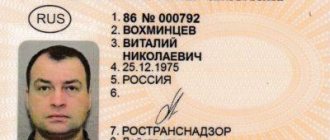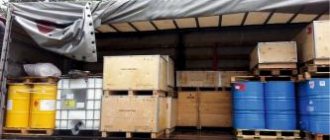Cargo transportation related to the transportation of substances classified as hazardous is strictly controlled and regulated by law. The thing is that, unlike ordinary cargo, hazardous substances, if the carrier deviates from the established standards, in the event of an unforeseen situation, will not only be able to cause enormous harm to the direct carrier of the product and bystanders, but also become the primary source of a global catastrophe that threatens the environmental situation, health, and often the lives of people.
There is a fine for violating the rules for transporting dangerous goods.
State standards oblige the cargo carrier’s legal documentation to ensure the maximum level of safety for the transported goods, and to issue special permits for the transit of products. For non-compliance with safety and lack of obligatory documentation, the cargo carrier is subject to significant penalties. In this article we will talk about the circumstances under which a fine is imposed for the transportation of dangerous goods by road, and we will consider the legal documents that oversee the transportation of unsafe categories of goods.
Laws defining standards for the transportation of exhaust gases
Unsafe products, regardless of their hazard class, are not prohibited by law from being transported. The only condition for transporting dangerous goods is that they are transported in accordance with the standards established by law, which ensure that unforeseen situations are kept to a minimum. To understand what liability a cargo carrier faces for violating the rules for transporting hazardous substances, it is necessary to familiarize yourself with the regulations relating to the transportation of products in this category.
The fundamental regulation coordinating the movement of dangerous goods is Article 12.21.2 of the Code of Administrative Offenses of the Russian Federation in the latest edition of the code dated May 2021. The document stipulates the penalties provided for non-compliance with certain rules for transporting harmful substances by road. Cargo transportation of exhaust gases by other modes of transport, with the exception of automobiles, is sanctioned by articles of the code 11.14 and 8.19. Additionally, legal standards can be adjusted by auxiliary domestic standards approved at the legislative level. These may be orders, annexes or regulations that regulate the correct organization of the movement of substances of a specific type.
How are violators punished?
The amount of the fine for violating the rules for transporting large and heavy cargo depends on the nature of the offense. Art. 12 of the Administrative Code establishes 4 forms of violations of the rules for the transportation of goods with appropriate sanctions:
For the first two offenses, the driver’s license is also confiscated and the vehicle is detained.
Violation of the rules for transporting goods by road that can be classified as dangerous is punished even more severely. According to the Administrative Code, Article 12, the fine for violating the rules for transporting goods of this kind for legal entities can reach half a million rubles.
Those responsible for violations may not be able to cope with fines alone - when violation of traffic rules and cargo transportation rules leads to human casualties, those responsible face criminal liability and a very real prison sentence. They judge “by the fact”: if 2 or more people died as a result of negligence, this promises the offender 9 years in prison.
However, the greatest responsibility lies not with drivers, but with legal entities - companies providing transportation services. This is also evident from the size of the fines - a material punishment of such severity will definitely affect the activities of the company, no matter how large it is. It is the head of the enterprise who is more interested than others in compliance with all legal requirements.
Driver's dream - hit 2021!
- DVR with radar detector and GPS informer.
- Notification of distance reduction and lane change. Antisleep function.
- Stay safe on the road with the Roadgid X7 Hybrid GT. Watch the video!
TODAY'S PROMOTION find out more>>>
Responsibility for illegal movement of exhaust gas
Sanctions for transporting dangerous goods if their movement does not comply with established rules vary depending on the type of violation. If the cargo carrier’s documentation is not officially documented, or the transit is carried out with incomplete compliance with all the rules established by law, responsibility for the incident may be assigned to the driver, the company implementing the transportation, or the customer of the services. The legislation provides for the following types of penalties for transporting exhaust gases in violation of transportation rules:
- financial penalty in the form of a fine;
- confiscation of property: mainly the vehicle and transported products;
- a ban on driving a specific type of vehicle for a period prescribed by law;
- criminal penalty.
The traffic police will be able to fine you for transporting dangerous goods on highways in an improper manner, and the fines will vary depending on the seriousness of the offense. Not only the entity directly transporting the goods, but also the goods transport company, as well as a legal entity authorized to control the transit delivery of products will be responsible for the incorrect movement of dangerous goods.
Section 12.21.2 of the code provides for the following financial penalties associated with the absence of certain papers or violation of the technical regulations:
- The absence of papers required for the transportation of unsafe substances provides for a fine in the range of one hundred to one hundred and fifty thousand in national currency for the direct carrier, from five to ten thousand units for the official entity. In this case, the trucking company may be punished for a larger amount, starting from one hundred and fifty thousand, with the upper limit of the accrual reaching two hundred and fifty thousand rubles. These penalties are applicable only in the absence of documents that are not licensing approvals, for the lack of which the punishment has more stringent parameters.
- If the violation concerns traffic regulations, then the penalties are two and a half, twenty and five hundred thousand rubles for the driver, official and company, respectively.
- Deviations from generally accepted requirements for the technical condition of vehicles transporting unsafe goods are punishable by a fine of thirty to fifty thousand rubles, and the sanction is applied to the entrepreneur who is the owner of the vehicle. Additionally, officials and legal responsible persons may be fined up to thirty and one hundred thousand rubles, respectively.
Transportation fines
If a driver violates the rules for transporting goods, then he will definitely face a fine, which can be imposed in the amount of 500 - 500,000 rubles. Let's take a closer look at why a fine is imposed:
- If the driver violated the rule for transporting cargo and towing it during icy conditions, then the fine may be minimal, it is only 500 rubles, in some cases a verbal notification may be given.
- If heavy cargo was not transported in accordance with all the rules and there are no special documents or permits for this, then the carrier may be fined 2,500 rubles and even deprived of his driver’s license for six months. Particular attention should be paid if the driver is an official, then the fine may be 15,000 rubles, and a legal entity will have to pay 500,000 rubles.
- If there is a violation of the rules for transporting a heavy load that exceeds the weight by 5% of the declared weight, then the driver may face a fine of 1,000 rubles and up to 250,000 rubles. The monetary penalty will be calculated in accordance with the violation and the danger it poses to others.
- Penalties may also be imposed on carriers transporting bulk cargo. A fine is imposed if there is no additional equipment, for example, in this case an awning may be suitable. The cargo must be carefully enclosed to prevent damage to other vehicles during transport.
- If a vehicle is found that exceeds the permissible dimensions by 20 centimeters or weight by 20%, then the driver faces a fine of 3,000 to 4,000 rubles. For officials, this can all cost much more; as a rule, the monetary penalty can be from 25,000 to 30,000 rubles, and a legal entity can pay 300,000. It is worth noting that if a violation was video recorded, then the owner of the vehicle will be punished directly.
- Violation of the rules for transporting dangerous goods and the absence of a certificate that the driver has undergone special training may threaten the driver with a fine of 1,000 to 2,500 rubles, and their driver’s license may be taken away for six months.
In any case, payment of a fine will be mandatory for violation, so it is easier to prepare all the necessary documents and strictly follow the rules and regulations established by law.
Sanctions for transportation of exhaust gases in the absence of documentary permission
To transport exhaust gas, it is necessary to have a package of documents that indicate the legality and safety of road transportation. Let's consider what fine for transporting dangerous goods without standardized approvals, state licenses and legal permits will be imposed on the contractor and the customer of transportation, as well as directly on the driver driving a vehicle with substances of an unsafe class. The driver transporting exhaust gas must have the following documents with him:
- driver's license, which provides the ability to operate a certain type of transport;
- route sheet, certified by authorized persons and filled out in accordance with established standards;
- access to a vehicle used during transportation;
- emergency card, which indicates all the nuances of handling transported substances and information about their hazard class, regulations for handling them;
- waybill;
- ADR is a European standard approval authorizing the possibility of transporting special products by an authorized person.
The last document is a permit issued in the name of the direct carrier of dangerous goods, which confirms his preparedness in the field of working with products of unsafe categories of certain classes.
Transportation of goods of a dangerous category without permission from the European Standard cannot be carried out and is punishable. ADR certifies that the driver has completed a training course on the specifics of handling a certain category of substances. Failure to obtain permission to transport hazardous gases in the form of admission will provide for the following penalties:
- A driver acting on behalf of an employer, working without ADR, will be fined by the relevant authorities in an amount, the upper limit of which is two and a half thousand rubles.
- A transport organization specializing in the delivery of exhaust gases will be punished with a fine, which starts at four hundred thousand, while the upper limit of the penalty can be five hundred thousand rubles.
- The official entity responsible for dispatching the disputed flight may be subject to an administrative penalty, ranging from fifteen to a maximum of twenty thousand rubles.
Similar sanctions are provided for by law if it is revealed that the vehicle in use does not have documents permitting its use for the purpose of transporting exhaust gases, the vehicle is not equipped with information and emergency signs, or it is not intended for transporting products of an unsafe category.
General classification of cargo
According to general transportation rules, all cargo is divided into several types depending on consistency and origin. Let's look at everything in more detail in the table:
| View | Description |
| Bulk and bulk | Grain, sugar, sand, ore, etc. |
| Dangerous | Any substances that pose a danger to people if containers are damaged and released into the environment |
| Oversized | All cargo exceeding at least one standard in length or width. If the excess weight is noticed, they are considered heavy. |
| Powdery (pulverized) | Any powdered substances: flour, sand, lime, cement, fertilizers |
| Gaseous | Any cargo whose delivery requires maximum tightness of containers: oxygen, nitrogen, propane |
| General | Any cargo with a piece nomenclature that can be transported in packaged or unpackaged condition |
| Perishable | These include goods with a limited shelf life: food, medicines |
Situations involving criminal penalties
For violation of the rules for the transportation of dangerous goods, the legislation provides not only administrative, but also criminal liability. Such situations are possible when aggravating circumstances exist, causing significant harm or the presence of factors that accompany an increased risk of harm to people or the environment. First of all, the legislation classifies as an aggravating factor the fact that the driver is intoxicated while driving when transporting exhaust gas. In such a situation, the executive authorities will be guided by the standards set out in Article 264, parts 4 and 6 of the Criminal Code, which provide for the following penalties for violators of the law:
- A person who provoked a precedent in which at least two people died could face up to nine years of arrest.
- A driver is threatened with restriction of freedom if he fails to comply with the requirements for the transportation of exhaust gases or traffic regulations, if the result is a fatal situation in which one person was injured. Based on the presence or absence of minor aggravating circumstances, the term can start from two years of arrest and reach seven years of imprisonment.
- The legislation provides for four to nine years of arrest for a person who provoked a situation causing harm to people, if the precedent does not record fatal cases. The period varies in this situation depending on the number of victims and the extent of damage caused to their health.
The Criminal Code of the Russian Federation in Chapter 264, Part 1 also provides for criminal punishment for a driver transporting substances of a dangerous category in an alcoholic state, even if no critical situations were recorded during transportation in the form of an accident or other precedents causing harm to the environment or people. If a driver is “caught” driving while drunk, and the precedent is not primary, he may be punished with a financial penalty of up to two hundred thousand rubles, or ordered to be detained for a period of up to twenty-four months.
The Criminal Code also provides for more severe penalties than fines for transportation in the following situations:
- Pollution of water space or land resources is punishable under sections 250 – 252 and 254 of the Criminal Code of the Russian Federation, respectively.
- For road transportation of environmentally unsafe products, during which damage to the natural environment is caused, punishment is sanctioned by Article 247.
- Illegal transportation of weapons or explosive products is punishable by law in accordance with Article 222 of the Criminal Code of the Russian Federation.
- Illegal import or export of goods used for the production of weapons of large-scale destruction and other similar products is regarded as a criminal offense and implies liability under Article 189.
The situations described above are considered criminal offenses; the criterion for punitive measures will be established by the relevant structures depending on the presence of aggravating factors, the degree of harm to the ecological environment, the presence and number of victims.
How to transport “oversized” items correctly?
A large-sized cargo, according to GOST, is one that exceeds the following “bars” in size.
- Width – 2.55 m.
- Length – 20 m.
- Height – 4 m.
Dimensions are checked with a simple telescopic ruler: traffic police inspectors do not use any innovative technologies when measuring.
Heavy cargo is a cargo whose weight, together with special transport, exceeds the limits established by law. There is no absolute maximum permissible weight of a “heavyweight” - the limit depends on the number of axles the car has.
- 2 axles – limit 18 tons.
- 3 axles – 25 tons.
- 4 axles – 32 tons.
“Heaviness” is determined not only by the weight of the cargo, but also by the load on one axle of the trawl. This is the second significant factor.
Transportation of “oversize” items is permissible only if all the conditions mentioned in paragraph 23 of the traffic rules are simultaneously met. The cargo should not
- Obstruct the driver's view.
- Affect vehicle stability.
- During transportation, create noise, raise dust, and cause damage to the environment.
- Block the reflectors and interfere with the perception of the driver’s hand signals.
The laws described above establish a number of prohibitions that the driver must take into account when transporting “oversize” items. It is forbidden
- Deviate from a predetermined route.
- Stop outside designated parking areas.
- Continue transportation, having information about the existing technical malfunction of the vehicle.
- Exceed the maximum permissible speed.
- Move on ice or when meteorological visibility is below 100 m.
- Go on a trip without special permission or with an expired document.
When transporting dangerous goods, the driver must also always observe certain safety precautions.
- Marking must be applied both to the cargo packaging and to the vehicle. The labeling must indicate what substance is being transported, as well as what hazard class is assigned to this substance.
- The driver should store in the car 2 fire extinguishers (minimum), a sandbag, a bucket, a shovel (at least small in size), and a wheel chock corresponding to the dimensions of the vehicle.
As with “oversized” vehicles, vehicles with dangerous goods must park, stop and refuel in specially designated areas. Violation of the rules for transporting dangerous goods by road leads to extremely severe sanctions - after all, such transportation is usually organized by legal entities.
Let's sum it up
Road transportation of goods of a specific category is an activity that requires a responsible attitude both to the transportation of products itself and to the preparation of relevant documentation. Penalties for transportation of exhaust gases that do not comply with the rules are quite strict, and the goods transport company suffers the most in such situations. To avoid problems with executive bodies and reduce the likelihood of violations, the company must enlist the support of experienced specialists who will be able to professionally supervise the transportation of exhaust gas, timely prepare the relevant documentation, and select driving personnel of a decent level.
Types of dangerous goods
The most severe punishment is provided for violation of the transportation of dangerous and explosive substances, so their classification should be considered in more detail.
The severity of the punishment is due to the fact that in the event of damage to the container as a result of an accident or irresponsible actions of the driver, the substances can end up in the environment, which is fraught with a huge catastrophe up to the introduction of a state of emergency.
Consider the situation:
The driver transports chemicals and gets into an accident. As a result of the accident, the truck overturns, liquid spills onto the roadway and contaminates everything within a 5 km radius. People experience tearing, coughing and suffocation attacks, and urgent evacuation is required. Both the cause of the accident and the cause of the liquid spill are being investigated. As a result, it was revealed that the company did not have a transportation permit, and the liquid itself was transported in violation of packaging rules.
Note! Each type of transport (railway, air, sea, road) has its own regulations, which may differ.
Class 1: explosives
This includes absolutely any substances that, in the event of an explosion, contaminate the rest of the cargo, and in the event of an accident can cause harm outside the vehicle.
They are divided into several subclasses:
- Objects and substances that spread during an explosion only inside the car;
- Elements characterized by non-mass scattering;
- Flammable substances with a minor projection hazard;
- Elements characterized by large mass explosions;
- Low-sensitive substances that cannot explode in large quantities.
In turn, such loads can react to shocks and impacts, increased temperature or sparks.
Dear reader! Didn't receive an answer to your question? Our expert lawyers work for you. It's absolutely free!
- Moscow ext 152
- St. Petersburg ext 152
- All regions ext 132 (Toll free)
Class 2: gases
Gases are always transported in special sealed vessels under pressure and are divided into several types:
- Oxidizing;
- Choking;
- Toxic;
- Toxic, corrosive or flammable;
- Oxidizing toxic.
There are also subclasses: compressed, liquefied, cooled, aerosol, dissolved under pressure.
Class 3: flammable items
Flammable items include any liquids and solid materials characterized by an increased fire hazard. They can easily ignite from sparks and other sources.
Class 4: oxidizing substances
Oxidizing substances include any substances that can provoke combustion by releasing other elements.
Class 5: infectious and toxic substances
Infectious should be understood as any substance containing pathogenic organisms:
- Organisms that are easily transmitted to people and animals, and are practically untreatable, and pose a particular danger;
- Organisms that are not always transmitted to other people and practically do not cause serious illness, and there are effective treatments against them;
- Organisms that can be transmitted to people but do not pose a threat to their health.
Grade 6: radioactive substances
Any objects and substances containing radionuclides are considered radioactive. Must be marked with special signs.
Grade 7: caustic substances
All liquids with corrosive properties that can cause serious damage as a result of contact with human skin can be classified as caustic. Some of them are especially dangerous because they emit toxic fumes that negatively affect the mucous membranes.
Class 8: other hazardous substances
This may include other substances that are not included in the categories and subcategories: liquid, solid, genetically modified organisms, water pollutants, lithium batteries, as well as items that, when exposed to fire, can emit toxic fumes.
Transportation of people and cargo, towing, training driving
| Article | Description | Sanctions/Measures |
| Article 12.21 part 1 | Violation of cargo transportation rules, as well as towing rules Information ⋅ Discussion | warning or fine of 500 rubles. |
| Article 12.21.1 part 1 | Movement of a heavy and (or) large vehicle exceeding the permissible dimensions of the vehicle by no more than 10 cm without special permission, or exceeding the dimensions specified in a special permit by no more than 10 cm, or exceeding the permissible weight of the vehicle or the permissible load on vehicle axle by an amount of more than 2, but not more than 10 percent without a special permit, or with an excess of the vehicle weight or vehicle axle load specified in the special permit by an amount of more than 2, but not more than 10 percent Information ⋅ Discussion | fine for the driver 1000-1500 rubles; for officials - 10-15 thousand rubles; for legal entities - 100-150 thousand rubles, in case of recording by cameras - for the owner of the vehicle 150 thousand rubles. |
| Article 12.21.1 part 2 | Movement of a heavy and (or) large vehicle exceeding the permissible dimensions of the vehicle by more than 10, but not more than 20 cm, or exceeding the permissible weight of the vehicle or the permissible load on the axle of the vehicle by more than 10, but not more than 20 percent, without special permission Information ⋅ Discussion | fine for the driver 3000-4000 rubles; for officials - 25,000-30,000 rubles; for legal entities - 250,000 - 300,000 rubles, in case of recording by cameras - for the owner of the vehicle 300,000 rubles. |
| Article 12.21.1 part 3 | Movement of a heavy and (or) large vehicle exceeding the permissible dimensions of the vehicle by more than 20, but not more than 50 cm, or exceeding the permissible weight of the vehicle or the permissible load on the vehicle axle by more than 20, but not more than 50 percent, without special permission Information ⋅ Discussion | fine for driver 5-10 thousand rubles. or deprivation of rights for 2-4 months; for officials - 35-40 thousand rubles; for legal entities - 350-400 thousand rubles, in case of recording by cameras - for the owner of the vehicle 400 thousand rubles. |
| Article 12.21.1 part 4 | Movement of a heavy and (or) large vehicle exceeding the dimensions specified in the special permit by more than 10, but not more than 20 cm, or exceeding the weight of the vehicle or the load on the vehicle axle specified in the special permit by more than 10, but not more than 20 percent Information ⋅ Discussion | fine for the driver 3000-3500 rubles; for officials - 20-25 thousand rubles; for legal entities - 200-250 thousand rubles, in case of recording by cameras on the owner of the vehicle - 250 thousand rubles. |
| Article 12.21.1 part 5 | Movement of a heavy and (or) large vehicle exceeding the dimensions specified in the special permit by more than 20, but not more than 50 cm, or exceeding the weight of the vehicle or the load on the vehicle axle specified in the special permit by more than 20, but not more than 50 percent Information ⋅ Discussion | fine per driver 4000-5000 rubles. or deprivation of rights for 2-3 months; for officials - 30-40 thousand rubles; for legal entities - 300-400 thousand rubles, in case of recording by cameras - for the owner of the vehicle 400 thousand rubles. |
| Article 12.21.1 part 6 | Movement of a heavy and (or) large vehicle exceeding the permissible dimensions by more than 50 cm without a special permit, or exceeding the dimensions specified in a special permit by more than 50 cm, or exceeding the permissible vehicle weight or the permissible load on the vehicle axle by an amount of more than 50 percent without a special permit, or with an excess of the vehicle weight or vehicle axle load specified in the special permit by more than 50 percent Information ⋅ Discussion | fine for driver 7,000-10,000 rubles. or deprivation of rights for 4-6 months; for officials - 45-50 thousand rubles; for legal entities - 400-500 thousand rubles, and in case of recording by cameras - for the owner of the vehicle 500 thousand rubles. |
| Article 12.21.1 part 7 | Violation of traffic rules for heavy and (or) large vehicles, except for the cases provided for in parts 1 - 6 of this article Information ⋅ Discussion | fine for the driver 1000-1500 rubles; for officials responsible for transportation - 5,000-10,000 rubles; for legal entities - 50,000-100,000 rubles. |
| Article 12.21.1 part 8 | Provision by the shipper of inaccurate information about the weight or dimensions of the cargo in the documents for the transported cargo or failure to indicate in the waybill when transporting large-sized or heavy cargo information about the number, date or validity period of the special permit or about the route of transportation of such cargo, if this entailed a violation provided for in Part 1 , 2 or 4 of this article Information ⋅ Discussion | fine for citizens 1500-2000 rubles; for officials - 15-20 thousand rubles; for legal entities - 200 -300 thousand rubles. |
| Article 12.21.1 part 9 | Provision by the shipper of inaccurate information about the weight or dimensions of the cargo in the documents for the transported cargo or failure to indicate in the waybill when transporting large-sized or heavy cargo information about the number, date or validity period of the special permit or about the route of transportation of such cargo, if this entailed a violation provided for in Part 3 , 5 or 6 of this article Information ⋅ Discussion | fine for citizens 5,000 rubles; for officials - 25-35 thousand rubles; for legal entities - 350-400 thousand rubles. |
| Article 12.21.1.10 | Exceeding the permissible vehicle weight and (or) the permissible vehicle axle load, or the vehicle weight and (or) the vehicle axle load specified in a special permit, or the permissible vehicle dimensions, or the dimensions specified in a special permit, by legal entities or individual entrepreneurs, who loaded the cargo into the vehicle Information ⋅ Discussion | fine for individual entrepreneurs 80 -100 thousand rubles; for legal entities - 250-400 thousand rubles. |
| Article 12.21.1.11 | Failure to comply with the requirements prescribed by road signs prohibiting the movement of vehicles whose total actual weight or axle load exceeds those indicated on the road sign, if the movement of such vehicles is carried out without special permission. Note. For administrative offenses provided for in this article, persons carrying out entrepreneurial activities without forming a legal entity bear administrative liability as legal entities. Information ⋅ Discussion | a fine of 5,000 rubles. |
| Article 12.21.2part 1 | Transportation of dangerous goods by a driver who does not have a certificate of training for drivers of vehicles transporting dangerous goods, a certificate of vehicle approval for the transportation of dangerous goods, a special permit or emergency card of the hazard information system provided for by the rules for the transportation of dangerous goods, as well as transportation of dangerous goods on a vehicle, the design of which does not comply with the requirements of the rules for the transportation of dangerous goods or which lacks elements of a hazard information system or equipment or means used to eliminate the consequences of an incident during the transportation of dangerous goods, or non-compliance with the conditions for the transportation of dangerous goods provided for by these rules Information ⋅ Discussion | fine per driver 2000-2500 rubles. or deprivation of rights for 4-6 months; for officials - 15-20 thousand rubles; for legal entities - 400-500 thousand rubles. |
| Article 12.21.2.2 | Violation of the rules for the transportation of dangerous goods, except for the cases provided for in Part 1 of this article Information ⋅ Discussion | fine for the driver 1000-1500 rubles; for officials - 5,000-10,000 rubles; for legal entities - 150-250 thousand rubles. |
| Article 12.22 | Violation of driving lessons rules by a driver teaching driving a vehicle Information ⋅ Discussion | warning or fine of 500 rubles. |
| Article 12.23 part 1 | Violation of the rules for transporting people, except for the cases provided for in Part 2 of this article Information ⋅ Discussion | fine 500 rub. |
| Article 12.23.2 | Transporting people outside the cabin of a car (except for cases permitted by traffic regulations), tractors, other self-propelled vehicles, on a cargo trailer, in a caravan trailer, in the back of a cargo motorcycle or outside the seating areas provided for by the design of the motorcycle Information ⋅ Discussion | fine 1000 rub. |
| Article 12.23.3 | Violation of the requirements for the transportation of children established by traffic regulations Information ⋅ Discussion | fine 3000 rub. |
All sections
* – in the case of recording an administrative offense using special technical means operating automatically, having the functions of photographing, filming, video recording, or means of photographing, filming, video recording (without the participation of traffic police inspectors) - a fine of 5,000 rubles.
You can always familiarize yourself with the current edition of the Code of the Russian Federation on Administrative Offenses on the official website of the State Traffic Safety Inspectorate of the Ministry of Internal Affairs of Russia.
Judicial practice under Article 12.21 of the Code of Administrative Offenses of the Russian Federation:
Decision of the Supreme Court: Resolution No. 14-AD17-2 of 05/03/2017 Judicial Collegium for Administrative Cases, supervision
Decision of the Supreme Court: Determination N 84-O09-30 dated May 14, 2009 Judicial Collegium for Criminal Cases, cassation
Decision of the Supreme Court: Determination N VAS-11142/13 dated 08/26/2013 Collegium for Administrative Legal Relations, supervision
Decision of the Supreme Court: Resolution N 205-AD16-3 of May 24, 2016 Judicial Collegium for Military Personnel, Supervision
Supreme Court decision: Resolution No. 5-AD16-250 of November 18, 2016 Judicial Collegium for Administrative Cases, supervision
Decision of the Supreme Court: Determination N 205-AD16-1 of 05/18/2016 Judicial Collegium for Military Personnel, Supervision
Supreme Court decision: Resolution No. 46-AD12-18 of 10/05/2012 Judicial Collegium for Administrative Cases, supervision
Decision of the Supreme Court: Determination N 84-DP11-4 dated July 20, 2011 Judicial Collegium for Criminal Cases, supervision
Comments ()
Write a comment
Related disorders
Unfortunately, not all rules are taken into account in paragraph 20 of the traffic rules, therefore, in order to have a complete picture of the rules for towing, it is necessary to refer to other paragraphs.
Speed
Paragraph 10.4 determines the maximum speed when towing, it is 50 km/h. If you are towing a trailer, you must adhere to the following speed limit:
- towing on the highway by passenger cars can occur at a speed of 90 km/h;
- on other roads - 70 km/h.
The size of the penalty will depend on the size of the violation. There is no liability for violating the speed limit by 20 km/h. For exceeding the speed limit by less than 40 km/h, an administrative fine of 500 rubles is provided. For exceeding the established speed limit by 40 to 60 km/h, the maximum fine is 1,500 rubles.
If the speed is exceeded by more than 60 km/h, then you can also lose your license. The administrative fine for exceeding 60 - 80 km/h ranges from 2000 to 2500 thousand, and you can lose your license for a period of 4-6 months. If the speed is exceeded by more than 80 km/h, then you will have to pay 5,000 rubles or lose your license for six months.
For such repeated violations, the amount of liability increases. The same violation is considered repeated if it occurs within one year.
In addition, clause 16.1 prohibits those vehicles that cannot reach a speed of more than 40 km/h from driving on the highway. That is, if the car is damaged during towing and does not allow you to drive faster than the established minimum value, you will have to pay a fine. It is provided for in Article 12.11 of the Administrative Code and amounts to 1000 rubles.
General Responsibilities
Many drivers of towed vehicles believe that they are not full participants in the traffic and therefore the usual requirements do not apply to them, but this is not the case.
Drivers of such vehicles, according to the rules of clause 2.1 of the traffic rules, must have all the necessary documents with them: a driver’s license, documents for the car, insurance, a certificate of disability, if the “disabled person” sign is affixed to the car.
If you don’t have the documents for the car with you, or you forgot your insurance or license, you’ll have to pay 500 rubles, but you can get off with a warning. If the insurance was not issued at all, and not simply forgotten, then the fine increases to 800 rubles and the alternative punishment in part 2 of Art. 12.37 Code of Administrative Offenses is no longer available.
If you do not have documents with you confirming the legality of using the “disabled person” information plate, then the driver will have to pay a fine of 5,000 rubles. For legal entities or officials Art. 12.4 of the Code of Administrative Offenses defines more serious liability as 500,000 and 20,000, respectively.
A fairly common situation is when a person who has no license at all has to be put behind the wheel of a towed vehicle in order to put a more experienced driver behind the wheel first. For handing over the steering wheel to a person who has the right to do so, the Code of Administrative Offenses in Art. 12.3 determines a fine of 3,000 rubles.
All vehicles entering the road must be properly registered and undergo inspection. Responsibility for violation of this rule is defined in Art. 12.1 of the Administrative Code and is a fine of 500 - 800 rubles. If a driver is caught again for the same violation within a year, he faces not only a fine of 5,000 rubles, but also imprisonment for a period of 1 to 3 months.
In accordance with paragraph 2.1.2, the driver must fasten his seat belt and ensure that his passengers also use seat belts. For violation of this rule, a fine of 1000 rubles is provided.
Lighting devices
When using a car, even if it is driven by another car, it is necessary to use lighting devices.
If the movement occurs at night or in weather conditions that limit visibility, then both it and the towing vehicle must turn on the “dimensions”. During the day, you need to turn on low beams or use fog lights.
Thus, clause 7.1 establishes the need to turn on the emergency alarm on the vehicle that is to be moved. If this is not possible due to a breakdown, then you need to use a warning triangle; it must be secured to the back of the car.
If you forget to turn on the headlights, then you face liability under Art. 12.20 Code of Administrative Offenses in the form of 500 rubles. The norm provides for an alternative punishment in the form of a warning.
The lighting devices themselves must comply with the Basic Provisions approved by Government Decree No. 1090 of October 23, 1993. If the requirements are not met, then citizens will need to pay 3,000 rubles.










